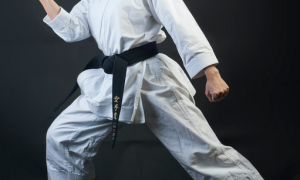
As practitioners progress through the Taekwondo Belt System, they find themselves facing an ultimate challenge—the black belt test. This pivotal moment is the culmination of years of training and preparation, where they are put to the test both physically and mentally. But what does a black belt test entail? What are the specific requirements that individuals must meet to attempt a Taekwondo black belt test? From physical conditioning to forms, sparring, and breaking techniques, we’ll delve into the multifaceted components that define this challenging yet rewarding experience.
Understanding the Taekwondo Black Belt Test
At the heart of the Taekwondo Black Belt Test lies a profound purpose – the culmination of relentless training, unwavering discipline, and the embodiment of the Taekwondo spirit. This test stands as a testament to the practitioner’s dedication and growth within the art. It is important to note that the testing procedures can vary among different Taekwondo schools, each carrying its own traditions and protocols. By exploring these stages, we aim to unravel the physical and mental challenges that participants must overcome to achieve the coveted Taekwondo Black Belt.
What are the Taekwondo Black Belt Test Requirements?
Mastery of foundational elements, such as all belt forms, kicks, and techniques, is of paramount importance before stepping into the testing arena. This preparation ensures that participants approach the test with confidence and a solid foundation to build upon. Here are key aspects that candidates must be prepared to demonstrate:
- Physical Fitness and Conditioning: Physical fitness is a fundamental requirement for a black belt test. The level of fitness expected may vary depending on the school, the specific grading panel, and the candidate’s age and physical condition. Endurance, strength, flexibility, and agility are all essential attributes that contribute to a successful test.
- Sparring Proficiency: Sparring, a dynamic and interactive component of Taekwondo, holds significant weight in the black belt test. Candidates must display competent sparring skills, showcasing effective defensive and offensive techniques, strategic footwork, and adaptability in real-time combat scenarios.
- Forms Mastery: Forms, known as “Poomsae” in Taekwondo, are choreographed sequences of movements that encapsulate fundamental techniques and principles. Candidates are expected to demonstrate proficiency in executing forms.
- Korean Taekwondo Vocabulary: Understanding essential Korean Taekwondo vocabulary is crucial. Candidates should be able to comprehend and execute commands and terms commonly used during training and testing. This linguistic competence underscores respect for the cultural and historical origins of Taekwondo.
- Demonstration of Techniques: Beyond forms and sparring, candidates may need to showcase their mastery of various techniques, including kicks, strikes, blocks, and combinations. These techniques exemplify the depth and diversity of Taekwondo’s arsenal.
- Breaking Techniques: Breaking, an integral aspect of Taekwondo, demonstrates a practitioner’s ability to harness power and precision. Candidates may need to execute predetermined breaking combinations, exhibiting control, focus, and accuracy.
- Etiquette and Behavior: Throughout the test, candidates are evaluated on their adherence to Taekwondo etiquette and behavior. Respect for instructors, fellow practitioners, and the art itself is paramount.
What are the Stages of a Black Belt Test?
Black belt tests in Taekwondo are as diverse as the martial artists who undertake them. While each school or examining body may have its unique approach, there are certain core elements that you can anticipate encountering during every black belt test. The following breakdown offers insights into the general stages that make up a Taekwondo black belt test.
1. Warmup
As you step onto the testing floor, the journey begins with an essential warm-up session. The goal is to prepare your body and mind for the upcoming physical and mental demands. This initial activity loosens your muscles, increases your heart rate, and primes your nervous system for the challenges ahead.
2. Cardio
Transitioning from warm-up, you are likely to move into some cardiovascular actives – a segment that mirrors the demands of real combat. In this stage, you perform a sequence of kicking combinations, traversing the studio space. The emphasis here is not only on the technical execution of kicks but also on building and maintaining cardiovascular stamina. As you progress through the ranks, the complexity and intensity of the kicking combinations increase, ensuring a constant challenge.
3. Forms: Precision in Motion
Mastery of forms is a cornerstone of Taekwondo. During this phase, you meticulously demonstrate all the belt forms you have learned, showcasing both technical accuracy and mental focus. The judges assess your ability to perform each form with precision, fluidity, and confidence. It’s a moment to display your understanding of the art’s fundamental movements and principles.
4. Kicks
The kicking segment highlights your mastery of fundamental kicking techniques. You’re expected to execute a series of kicks with power, control, and accuracy. This phase not only demonstrates your physical capabilities but also your technical proficiency. Each kick showcases your dedication to refining and perfecting your technique.
5. Sparring
Sparring is a critical test of your martial prowess. Engage in several rounds of sparring against skilled opponents, showcasing both physical endurance and tactical agility. As you face off against opponents, you’ll demonstrate your ability to adapt, strategize, and apply techniques under duress. This stage tests not only your physical fitness but also your mental resilience and quick decision-making.
6. Cardio Redux: Pushing Your Limits
Returning to the cardiovascular realm, this phase reintroduces cardio exercises that challenge your stamina. The repetition emphasizes the vital role of cardiovascular fitness in maintaining optimal performance throughout the test. It’s a reminder that endurance remains a key asset in the world of Taekwondo.
7. Board Breaking
Breaking techniques are a testament to your explosive power and precision. In this stage, you’re tasked with executing dynamic kicking combinations to break boards. This segment highlights your ability to channel energy effectively and deliver controlled yet forceful strikes. The breaking phase reinforces your understanding of the physics behind martial arts techniques.
The Different Black Belt Test Requirements Across ATA, WTF, and ITF Taekwondo
Taekwondo encompasses multiple styles, each with its own set of standards and requirements for achieving a black belt. The Association of Taekwondo (ATA), the International Taekwon-Do Federation (ITF), and the World Taekwondo Federation (WTF) are three prominent styles, each with distinct testing criteria. This section delves into the varying requirements of these styles and presents a comparative table for quick reference.
Association of Taekwondo (ATA) Black Belt Testing Requirements
The ATA places a strong emphasis on comprehensive skill development. Black belt testing in ATA involves a combination of physical techniques, forms, sparring, and board breaking. Below is an overview of the ATA’s black belt testing requirements:
Aspect |
Requirements |
|---|---|
| Physical Techniques | Mastery of various kicking and striking techniques. |
| Forms | Proficiency in prescribed forms relevant to belt level. |
| Sparring | Demonstrate effective sparring techniques and strategies. |
| Board Breaking | Successfully breaks boards with precise techniques. |
International Taekwon-Do Federation (ITF) Black Belt Testing Requirements
ITF Taekwondo places significant emphasis on the execution of traditional techniques and patterns. The ITF black belt test focuses on fundamental skills, forms, and self-defense. Here’s a snapshot of the ITF’s black belt testing requirements:
Aspect |
Requirements |
|---|---|
| Fundamental Techniques | Proficiency in fundamental strikes, kicks, and blocks. |
| Patterns (Tuls) | Precise execution of prescribed patterns for each belt. |
| Self-Defense | Demonstrate effective self-defense techniques. |
World Taekwondo Federation (WTF) Black Belt Testing Requirements
WTF Taekwondo, often referred to as Olympic-style Taekwondo, emphasizes sportive sparring and high-intensity physical conditioning. The WTF black belt test focuses on sparring, patterns, and athletic performance. Here’s a glimpse of the WTF’s black belt testing requirements:
Aspect |
Requirements |
|---|---|
| Sparring | Effective and strategic sparring techniques. |
| Patterns (Poomsae) | Precise execution of patterns showcasing form and balance. |
| Physical Conditioning | Endurance, flexibility, and strength exercises. |
Comparative Table: Black Belt Test Requirements
Aspect |
ATA |
ITF |
WTF |
|---|---|---|---|
Physical Techniques |
Kicking, Striking | Fundamental Techniques | Physical Conditioning |
Forms |
Belt-specific Forms | Patterns (Tuls) | Patterns (Poomsae) |
Sparring |
Effective Sparring | N/A | Strategic Sparring |
Board Breaking |
Precision Board Breaking | N/A | N/A |
Self-Defense |
Demonstrated Techniques | Self-Defense Techniques | N/A |
Emphasis |
Comprehensive Skills | Traditional Techniques | Sportive Sparring |
In conclusion, the requirements for achieving a black belt in Taekwondo vary across styles, reflecting the distinct philosophies and focuses of each tradition. Whether through comprehensive skill development (ATA), precise execution of patterns (ITF), or a blend of sportive techniques and conditioning (WTF), the journey to a black belt is a testament to the diversity within the art of Taekwondo.
Taekwondo Black Belt Test Tips
As you prepare to embark on the journey towards your Taekwondo black belt, strategic preparation and focused training can significantly enhance your chances of success. Here are some essential tips to keep in mind as you gear up for the ultimate test of your martial arts skills:
- Build Cardiovascular Endurance: The physical demands of a black belt test require robust cardiovascular endurance. Incorporate activities like running, cycling, and interval training into your routine to bolster your stamina and sustain your energy throughout the test.
- Master All Belt Forms: Be prepared to demonstrate all the forms you’ve learned throughout your journey. Review each form meticulously, ensuring precision in movements and transitions. Remember, you might be asked to perform any form, so a comprehensive understanding is key.
- Refine Your Kicks: Practice kicks extensively, both on training pads with a partner and in the context of board-breaking techniques. Ensuring your kicks are powerful, accurate, and controlled will not only contribute to your success in the test but also enhance your overall martial arts proficiency.
- Increase Sparring Practice: Engage in more sparring sessions leading up to the test. This will not only enhance your sparring skills but also familiarize you with adapting to different opponents and fighting under fatigue.
- Practice Board Breaking: If breaking boards is part of your test, practice different breaking techniques and combinations. Build your confidence in executing clean and powerful breaks while maintaining proper form.
- Seek Guidance: Don’t hesitate to approach your instructors or fellow practitioners for guidance and feedback. Their insights can offer valuable perspectives on areas that need improvement.
FAQ
What is involved in a black belt test?
A black belt test is a comprehensive assessment of a martial artist’s skills, knowledge, and dedication. It typically includes a series of physical challenges such as warm-up exercises, kicking combinations, push-ups, sit-ups, form demonstrations, sparring rounds, board-breaking techniques, and more. The test aims to evaluate both physical proficiency and mental resilience.
Can you fail a belt test?
Yes, it is possible to fail a belt test if you do not meet the required standards set by your Taekwondo school. However, failure should not be seen as a setback but rather as an opportunity to identify areas for improvement. Your instructors are there to help you grow, and a failed test can be a stepping stone towards eventual success.
What should I eat before a belt test?
Before a belt test, opt for a balanced meal that provides sustained energy. Focus on complex carbohydrates (whole grains, fruits, vegetables), lean protein sources (chicken, fish, tofu), and healthy fats (nuts, seeds, avocado). Avoid heavy or greasy foods that might lead to discomfort during physical activities. Stay hydrated by drinking water throughout the day.


